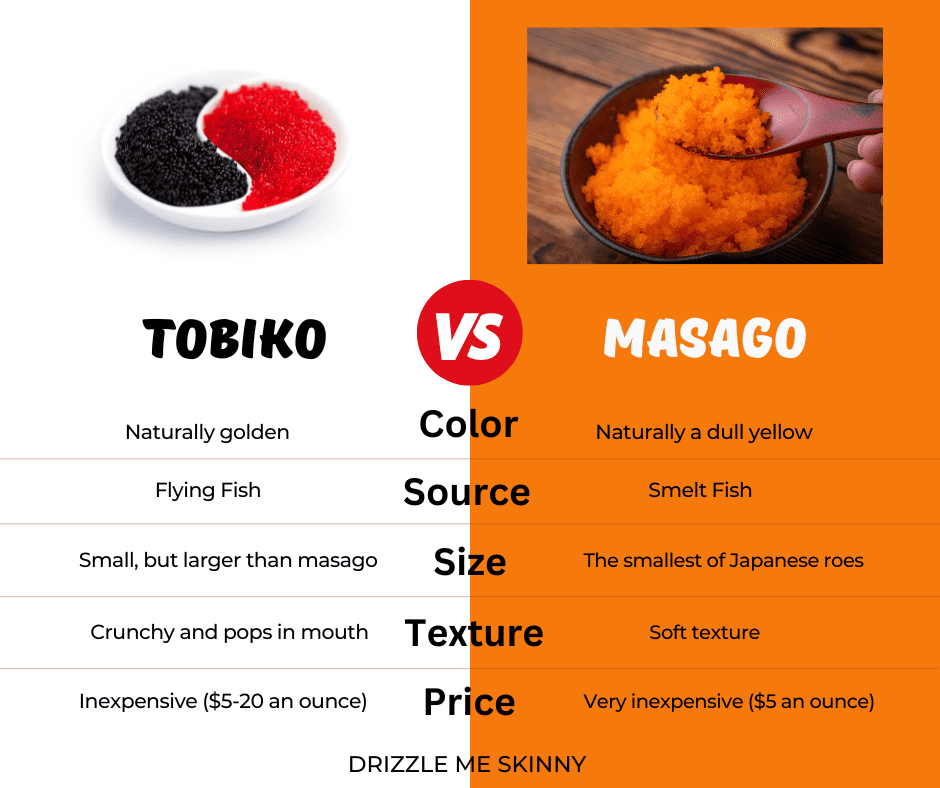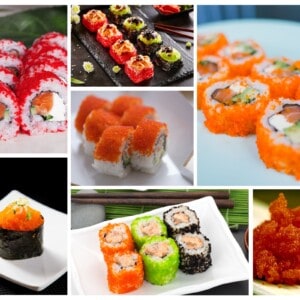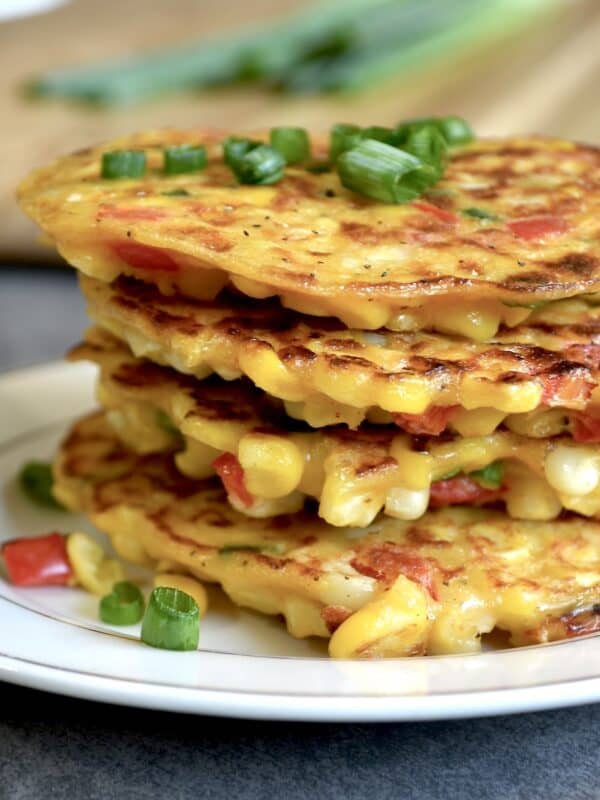Tobiko and masago are two popular types of fish eggs used in Japanese cuisine. Commonly added to sushi, sashimi, and other dishes, both types of fish roe provide an exciting pop of color, flavor, and texture.
While they are often used interchangeably in Japanese food, there are some significant differences between tobiko vs masago. In this guide, we explain where they come from, how they taste, how to use them, and more. Let’s dive in!
What is tobiko?
Tobiko is a Japanese word derived from the term “tobiuo no ko,” meaning “flying fish eggs.” meaning fish eggs or roe. Tobiko is harvested from one of the dozens of species of Japanese flying fish.
Tobiko is commonly used as a colorful and crunchy garnish atop sushi rolls and sashimi or as a main ingredient served on a bed of rice. As with other types of roe, unfertilized eggs are harvested from the female fish and then cured for favor and to increase the shelf life.
Types of tobiko
The freshest and most expensive tobiko is typically cured salt and maintains a light golden color. The flavor is slightly sweet, citrusy, and briny. Most tobiko found in stores are more processed and thus include other ingredients that change the color and taste.
Here are the most popular types of tobiko:
- Golden tobiko is the purest and freshest form and is cured using only salt. Some lesser-quality golden varieties may be dyed with food coloring.
- Orange tobiko is the most common commercially-processed variety and was popularized by its use on the California roll. It tastes sweet, briny, and citrusy.
- Black tobiko gets its color from squid ink and has a more umami-rich flavor than other varieties. It has mildly nutty and bitter notes as well.
- Red tobiko gets its color and flavor from the addition of beets or chilis. Food dye is used to deepen the vibrant color.
- Yellow tobiko is usually flavored with yuzu (Japanese lemon) zest or other citrus fruits. Its bright yellow color comes from food dye.
- Green tobiko is infused with wasabi, resulting in a stronger and spicier flavor than other varieties.
What does tobiko taste like?
Tobiko has a crunchy texture that pops in your mouth. Unprocessed tobiko eggs have a mild flavor that is both sweet and briny with citrusy undertones. Unlike masago, tobiko also has some smokey undertones.
As mentioned above, tobiko can be processed in a variety of ways, which can subtly alter the flavor profile. Most commercial tobiko is cured with some combination of sake vinegar, mirin, salt, sugar, soy sauce, and dashi (an aromatic Japanese broth).
Is tobiko same as caviar?
While both are types of fish eggs, tobiko and caviar are in different categories due to appearance, taste, texture, exclusivity, and price. Caviar is harvested exclusively from mature fish of the sturgeon species. These fish are rare and take a minimum of 10 years to mature. Caviar eggs are large, shiny, and have a variety of naturally-occurring colors and patterns.
How to use tobiko roe
So what is tobiko good with? Tobiko is an enjoyable addition to sushi rolls, sashimi, and other seafood dishes or consumed on its own over a bed of rice. It can be wrapped with ric in nori seaweed to make gunkan sushi. Other uses for tobiko include a garnish for crabcakes, salads, and omelets or atop a cracker with some cheese.
Where to buy tobiko
Aside from Japanese restaurants, where tobiko is very popular, you can find this inexpensive roe variety in Asian grocery stores and markets or buy it online. High-end seafood markets may also carry tobiko. Because the eggs freeze well, they are available year-round.
Is tobiko expensive?
Compared to caviar, tobiko is not very expensive (though it is slightly more expensive than masago). You can buy commercial tobiko for anywhere from $5-$20 per ounce.
Best sushi recipes using tobiko
Give tobiko a try on a classic California roll, like this one from Just One Cookbook, or get creative and make a Lion King Roll, courtesy of How Daily!
What is masago?
Masago is the roe from the smelt family of fish, such as capelin smelt in the North Atlantic, Pacific, and Arctic oceans, and shishamo smelt from the Pacific Ocean around Japan. Masago means sand in Japanese and is indicative of its small size. (Capelin eggs are roughly 1 millimeter in diameter!)
Not only is it significantly smaller than tobiko, but it is duller in color and has a softer texture. Like tobiko, masago is translucent.
Types of masago
Just like tobiko, there are many varieties of masago, resulting from differences in the curing process. The most common colors of masago are bright orange, black and red. Here’s a breakdown of the types of masago:
- Orange masago has a mildly sweet and salty flavor with hints of umami. It gets its color from food dye and is flavored with soy sauce, corn syrup, salt, and MSG.
- Black masago looks like black tobiko, but it gets its color solely from food dye rather than squid ink. It usually contains salt, corn syrup, soy sauce, and MSG.
- Red masago tastes like its orange counterpart as it’s simply colored with a different variety of dyes.
- Wasabi masago is flavored with wasabi or horseradish and colored with yellow and blue food dyes. Salt, soy sauce, corn syrup, and MSG are also used.
What does masago taste like?
Masago taste very similar to tobiko, although slightly milder. It has a subtly sweet, salty, and citrusy flavor. Masago is typically cured in soy sauce, MSG, high fructose corn syrup, and food coloring agents, resulting in its briny flavor and vibrant colors.
As mentioned above, masago can be processed in a variety of ways, which can subtly alter the flavor profile. Most commercial tobiko is cured with some combination of sake vinegar, mirin, salt, sugar, soy sauce, and dashi (an aromatic Japanese broth).
Is masago same as caviar?
Masago and caviar are both fish roes, but they are harvested from different species of fish. True “caviar” comes from species of sturgeon fish, which are rare and take upwards of 10 years to mature. Caviar is much bigger and differs in taste, texture, color, and price.
How to use masago
Masago is used interchangeably with tobiko: as a garnish for sushi rolls, sashimi, and other seafood and rice dishes. It can also be made as a creamy masago sauce served with sushi rice, sushi rolls, seafood dishes, and even pasta.
Where to buy masago
You can buy masago anywhere that you buy tobiko, which includes Asian grocery stores and markets, high-end seafood markets, and online. Masago freezes well and thus is typically available year-round in the frozen section.
Is masago expensive?
Masago is the least expensive of any fish roe used in Japanese cooking, and it is certainly less expensive than caviar. Masago costs around $5 per ounce.
Best masago recipes
Head over to Yummy Mummy Kitchen for a masago sushi recipe that is both beautiful and authentically delicious. For a creamy and aromatic masago sauce recipe, Half Scratched has got you covered!

Summary: What’s the difference between tobiko and masago?
While these fish eggs are used interchangeably in Japanese cuisine, there are some notable differences when comparing tobiko vs masago.
- Color: The natural color of tobiko is golden color, while masago is a duller yellow color. Both are colored with natural ingredients and dyes during curing.
- Source: Tobiko is flying fish roe while masago is the eggs of smelt fish.
- Size: Both are smaller than caviar and other roes, but of the two, tobiko is larger. Masago means “sand” in Japanese, a testament to its small, grainy size.
- Texture: Tobiko has a crunchier texture and pops in your mouth. Masago has a bit of a crunch but is much softer than tobiko.
- Price: Tobiko and masago are both affordable roe varieties. Of the two, masago is less expensive. Both can be found online and in Asian grocery stores.
Related Recipes
Now that you’re a fish egg expert, continue your Japanese cuisine education with two of our top trending posts: Ramen vs Udon and Nigiri vs Sashimi!
And if your mouth is drooling for sushi, you’ll definitely want to check out these 25 Restaurant-Quality Sushi Recipes! (Don’t forget to add some roe!)
Frequently Asked Questions (FAQs)
Q1: Is tobiko the same as masago?
A: No. While both are types of fish eggs popular in Japanese cuisine, they come from different species of fish and are different in appearance, taste, texture, and price.
Q2: Can you eat fish eggs while pregnant?
A: Fish eggs are safe to consume in moderation during pregnancy as long as they are pasteurized and properly refrigerated.
Q3: Is fish roe healthy to eat?
A: Fish roe is very nutritious. Fish eggs are high in protein, omega-3 fatty acids, phosphorus, selenium, folate, choline, antioxidants, and vitamins A, B12, and D.
Tobiko vs Masago

Instructions
- Choose your favorite Recipe
- Click the link to view the instructions
- Follow linked instructions
- enjoy!





